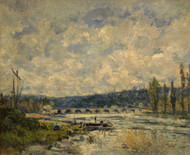Alfred Sisley (1839-1899)
Published by Therese Myles on 17th Sep 2019
Alfred Sisley was an incredibly famous expressionist painter who was born in Paris on October the 30, 1839 from the family of a well-to-do businesswoman, and when he was growing up he was preparing for a career of commerce, to follow in his family's footsteps. When he was twenty-three years old, Sisley decided that he wanted to become a painter, and subsequently entered the Atelier Gleyre school in Paris, where he met Monet, Renoir, even Bazille, and became fast friends with them, working with them often in the expansive, open forests of Fontainebleau, found in the suburbs of Paris. In 1866, after staying in Atelier Gleyre for 4 years, he sent his first paintings to the Paris Salon, then Alfred Sisley was subsequently exhibited there from 1868-1870.
During the Franco-Prussian War, Sisley became a victim to the conflict, and lost all of his possessions when the Prussian army overran and destroyed his family's estate in the countryside outside of Paris. His father was completely ruined after the war, so the artist was left in destitute poverty and forced to help support his family for many years, finding himself forced to work and live in the countryside west of Paris, even after his classical training in the town- mainly in around Marly, Louveciennes, and Villenueve-la-Gareenne, and Bougival, and often the way that fate attached itself to a place was the subject of his paintings- like the flood of 1876, which became the subject of his landscape paintings. After being exposed to landscape painting, he found himself almost exclusively painting landscapes with the banks of Seine and the Loing and Sablon- where he lived from 1889 until his death in 1899; never really leaving the towns around where he lived, painting several very famous landscapes: Canal du Louing at St. Mammes, Matrat's Boatyard, Moret-sur-Loing, and Courtyard of Farm at St. Mammes.
Most of Sisley's notable paintings were very tranquil and peaceful, containing pale shades of green, pink, purple, dusty blue, and cream, and what's really interesting about his painting style is that his power of expressionism was said to have been displayed through color intensity changes within his Sisley's individual paintings.
Unfortunately for Sisley, his artwork, talent and impressionism were not fully recognized or appreciated until after his death. He spend most of his life in abject poverty, after his family lost their estates and everything they owned after the Franco-Prussian War, and only earned enough money to make a few brief trips to Britain, to sell some of his works. Sisley always found himself overshadowed by Monet, who had the same style and subject matter, however subdued Sisley's effects were that really drew the two apart. Another interesting fact; there are a multitude of fake of Alfred Sisley's paintings, making them extremely valuable, which explains why many of his paintings in museums, namely Alee des peupliers de Moret has been stolen more than three times from the museum in Nice, France. Furthermore, in Alfred Sisley's short 59 year lifespan, he created over 900 oil paintings, 100 pastels, and numerous other drawings, leaving a significant impression in the art world.

